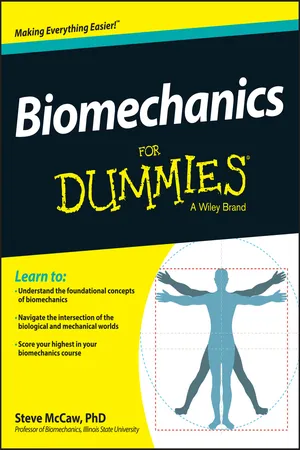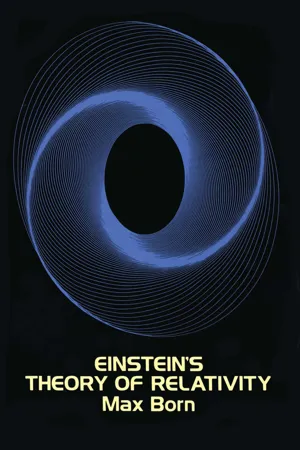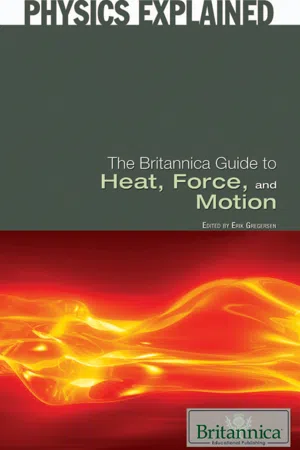Physics
Linear Motion
Linear motion refers to the movement of an object in a straight line, with constant velocity or acceleration. It is characterized by the absence of rotation or angular movement. In linear motion, the object's position, velocity, and acceleration can be described using equations that involve time and initial conditions.
Written by Perlego with AI-assistance
Related key terms
6 Key excerpts on "Linear Motion"
- eBook - ePub
- William Bolton(Author)
- 2012(Publication Date)
- Routledge(Publisher)
4 Linear and angular motion 4.1 Introduction This chapter is concerned with the behaviour of dynamic mechanical systems when there is uniform acceleration. The terms and basic equations associated with Linear Motion with uniform acceleration and angular motion with uniform angular acceleration, Newton’s laws of motion, moment of inertia and the effects of friction are revised and applied to the solution of mechanical system problems. The terms scalar quantity and vector quantity are used in this chapter, so as a point of revision: Scalar quantities are those that only need to have their size to be given in order for their effects to be determined, e.g. mass. Vector quantities are those that need to have both their size and direction to be given in order for their effects to be determined, e.g. force where we need to know the direction as well as the size to determine its effect. 4.2 Linear Motion The following are basic terms used in the description of Linear Motion, i.e. motion that occurs in a straight line path rather than rotation which we will consider later in this chapter: 1 Distance and displacement The term distance tends to be used for distances measured along the path of an object, whatever form the path takes; the term displacement, however, tends to be used for the distance travelled in a particular straight line direction (Figure 4.1). For example, if an object moves in a circular path the distance travelled is the circumference of the path whereas the displacement might be zero if it ends up at the same point it started from - eBook - ePub
- Steve McCaw(Author)
- 2014(Publication Date)
- For Dummies(Publisher)
translation. In Linear Motion, all points on a body go equally far in the same direction, they travel equally fast, and they move at the same time. All points on the body also speed up and slow down at the same time. There are two forms of Linear Motion:- RectiLinear Motion: Motion in a straight line.
- CurviLinear Motion: Motion along a curved line, such as when a body moves through the air as a projectile. CurviLinear Motion is simultaneous motion in the up–down (vertical) and forward–backward (horizontal) directions.
In this chapter, I explain the kinematic descriptors to describe where a body is in space (position) and how far, how fast, and how consistently (speeding up or slowing down) the body moves. I introduce the important quantity of linear momentum because it combines the two critical ideas of the body's current state of motion and the body's resistance, or inertia, to changing its motion. Finally, I demonstrate the use of the three equations of constant acceleration to quantify projectile motion.Identifying Position
Position describes a body's location in space. The location is specified relative to a selected landmark. The landmark is referred to as the origin, because all measures of position are made from, or originate from, this point. Figure 5-1 shows a view from above of a player on a soccer field (or pitch, to be sport-term correct) at a specific instant in time. I've set the origin to a coordinate system (see Chapter 2 ) where the goal line and the sideline meet in the bottom-left corner of the field; the x direction corresponds to the length of the field, and the y - eBook - ePub
- Max Born(Author)
- 2012(Publication Date)
- Dover Publications(Publisher)
All these definitions become rigorous, and at the same time convenient to handle, if the process of subdivision into small intervals during which the quantity under consideration may be regarded as constant is carefully studied. This leads to the concept of limiting value which forms the starting point of the differential calculus. Historically, it was when Newton was investigating the problems of motion that he was actually led to invent the differential calculus and its inverse, the integral calculus.The theory of motion (kinematics, phoronomy) is the forerunner of the proper mechanics of forces, or dynamics. It is evidently a sort of geometry of motion. As a matter of fact, in our graphical representation each motion is represented by a geometric configuration in the plane with the coordinates x, t. In this we are concerned with more than a mere analogy. For it is the principle of relativity that attaches fundamental importance to the introduction of time as a coordinate in conjunction with the spatial dimensions.3. Motion in a Plane
If we wish to study the motion of a point in a plane, we can at once extend our method of representation to this case. We take in the plane an xy-coordinate system and erect a t-axis perpendicular to it (Fig. 14 ). Then a straight line in the xyt-space corresponds to a rectilinear and uniform motion in the xy-plane. For if we project the points of the straight line that correspond to the points of time t = 0, 1, 2, 3,... sec. on to the xy-plane, we see that the positional displacement takes place along a straight line and at equal intervals.Fig. 14 Uniform motion in a plane represented in an x, y, t-coordinate system After 1, 2, 3, 4,...sec. the point in the x y-plane has reached the foot of the parallel line which bears the number 1, 2, 3, 4,...respectively.Every nonrectiLinear Motion is said to be accelerated even if, for example, a curved path is traversed with constant speed. For in this case the direction of the velocity changes although its numerical value remains constant. An accelerated motion is represented in the xyt-space (Fig. 15 ) by an arbitrary curve. The projection of this curve into the xy-plane is the plane orbit. The velocity and the acceleration are again calculated by supposing the curve replaced by a polygon closely wrapped around the curve. At each corner of this polygon not only the amount but also the direction of the velocity alters. A more exact analysis of the concept of acceleration would take us too far; it is sufficient to mention that it is best to project the graph of the moving point onto the coordinate axes x, y, and to follow out the rectiLinear Motion of these two points, or what is the same, how the coordinates x, y change with time. The concepts defined for rectiLinear Motions as given above may now be applied to these projected motions. We thus get two components of velocity vx , vy , and two components of acceleration bx , by - eBook - ePub
- Brendan Burkett(Author)
- 2018(Publication Date)
- Human Kinetics(Publisher)
At the upper end of technology, modern radar equipment that is used in sport research can provide information about speed and distance of an athlete or object. Radar technology can calculate the speed of a baseball as it leaves the pitcher’s hand or as it leaves the bat at the instant it is hit. This equipment is now so precise that it can determine over what distance a sprinter was accelerating. It can also give the distance over which the athlete held a particular speed during a race and by how much the athlete decelerated at the end of a race.At a Glance Linear Motion Measures- Speed is a scalar measure indicating how fast an object is traveling, measured by dividing the length or distance traveled by the time. Speed does not quantify the direction of travel.
- Velocity is the change in position divided by the time and includes the direction of travel.
- Velocity can be in the horizontal direction, the vertical direction, or the resultant of these two components.
- Acceleration is the rate of change of velocity; an increase or decrease indicates acceleration or deceleration.
- Current-day technologies can be adopted to automate (or semiautomate) the process of measuring linear velocity.
How Linear Motion Occurs
For an object to move or remain stationary, some influence of force needs to occur; that is, a force must hold the object stationary or make it move. What exactly do we mean by force? You cannot actually see a force, but you can see and experience its effects. A force is a push or a pull that changes or tends to change the shape or the state of motion of an athlete or object. Here’s an example to explain what we mean by tends to .Imagine a weightlifter attempting to lift a barbell from the floor in a vertical direction. The athlete reaches down and pulls on the bar. If she pulls hard enough and applies sufficient force, the barbell is hoisted upward. But what happens if she doesn’t apply enough force to move the barbell? In this situation you could say there is a tendency for the athlete to set the barbell in motion—it is closer to moving with the athlete pulling on it than if she wasn’t pulling on it. - eBook - ePub
Doing Physics with Scientific Notebook
A Problem Solving Approach
- Joseph Gallant(Author)
- 2012(Publication Date)
- Wiley(Publisher)
Chapter 2One-Dimensional Kinematics
We start Doing Physics with SNB in the branch of physics known as Classical Mechanics. Our study of Classical Mechanics begins with one-dimensional kinematics, the description of motion in a straight line. This includes horizontal motion to the right or left and vertical motion straight up or down. This description will tell us where an object is, where it is going, and how much time it took to get there.Constant Acceleration
Studying motion with a constant acceleration is a good place to start. We can describe this motion completely without using calculus. Let’s start with some definitions and important distinctions, and then we’ll solve some one-dimensional problems.Displacement and Position
To describe an object’s motion, we need to establish a coordinate system so we can specify location. For 1-dimensional motion the coordinate system is just the x-axis with the origin at x = 0 and positive values to the right. The object’s position, specified by its x-coordinate, tells us how far from the origin it is and in which direction.The displacement is the object’s change in position.(2.1)This difference between the object’s final and initial position tells us how far from its original position it ends. A positive displacement means the object ends to the right of x0 and a negative displacement means the object ends to the left of x0 . For a round trip, the initial and final positions are equal and the displacement is zero. The SI unit for both position and displacement is the meter (m).Note The use of the upper case Greek letter delta (“Δ”) to mean “change in” is standard mathematical notation, but it has no special significance in SNB. In a calculation, SNB interprets the expression Δf as Δ x f, the product of two variables.Even though they have the same unit, displacement and distance are different. Suppose you start 2 meters from the origin, walk 9 meters to the right, turn around and walk 5 meters back toward the origin. Your initial position was x0 = 2 m and your final position is x = 6m, so your displacement is Δx - eBook - ePub
- Britannica Educational Publishing, Erik Gregersen(Authors)
- 2010(Publication Date)
- Britannica Educational Publishing(Publisher)
CHAPTER 4 THE LAWS OF PARTICLE MOTIONT he applications of Newton’s laws are wide-ranging. They can explain the motion of a pebble falling to the ground, a pendulum swinging in a grandfather clock, or a planet orbiting a distant star.MOTION OF A PARTICLE IN ONE DIMENSION
The simplest problems in mechanics involve a particle moving in one dimension—in other words, on a line. Such problems include those of falling bodies and masses oscillating back and forth.UNIFORM MOTIONAccording to Newton’s first law (also known as the principle of inertia), a body with no net force acting on it will either remain at rest or continue to move with uniform speed in a straight line, according to its initial condition of motion. In fact, in classical Newtonian mechanics, there is no important distinction between rest and uniform motion in a straight line; they may be regarded as the same state of motion seen by different observers, one moving at the same velocity as the particle, the other moving at constant velocity with respect to the particle.Although the principle of inertia is the starting point and the fundamental assumption of classical mechanics, it is less than intuitively obvious to the untrained eye. In Aristotelian mechanics, and in ordinary experience, objects that are not being pushed tend to come to rest. The law of inertia was deduced by Galileo from his experiments with balls rolling down inclined planes.For Galileo, the principle of inertia was fundamental to his central scientific task: he had to explain how it is possible that if Earth is really spinning on its axis and orbiting the Sun we do not sense that motion. The principle of inertia helps to provide the answer: Since we are in motion together with Earth, and our natural tendency is to retain that motion, Earth appears to us to be at rest. Thus, the principle of inertia, far from being a statement of the obvious, was once a central issue of scientific contention. By the time Newton had sorted out all the details, it was possible to account accurately for the small deviations from this picture caused by the fact that the motion of Earth’s surface is not uniform motion in a straight line. In the Newtonian formulation, the common observation that bodies that are not pushed tend to come to rest is attributed to the fact that they have unbalanced forces acting on them, such as friction and air resistance.
Index pages curate the most relevant extracts from our library of academic textbooks. They’ve been created using an in-house natural language model (NLM), each adding context and meaning to key research topics.





